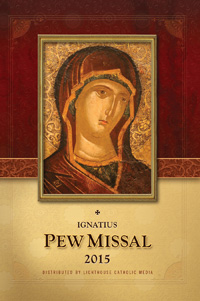 Lighthouse Catholic Media and Ignatius Press have teamed up to bring us The Ignatius Pew Missal. The Missal is produced a complete annual volume coming in at 525 pages. You might be asking yourself, Why do we need another missal? I will let the publisher answer that question before I get into the rest of my review:
Lighthouse Catholic Media and Ignatius Press have teamed up to bring us The Ignatius Pew Missal. The Missal is produced a complete annual volume coming in at 525 pages. You might be asking yourself, Why do we need another missal? I will let the publisher answer that question before I get into the rest of my review:
Its purpose is simple: to provide worshipers with a liturgical resource that is consistent with the directives of the Church and accessible to the average parishioner, especially in regards to music. This is done in two ways: by using simple plainsong melodies for the Entrance and Communion antiphons, so that a cantor, choir, and even a congregation can easily sing them, and by selecting hymns and songs which, combined, provide a repertoire of sacred songs that is fitting for the Holy Sacrifice of the Mass, yet accessible for the average parish.
All Sunday and Holy Day lectionary readings for the liturgical year are included. There are 189 hymns which cover Advent, Lent, Easter, Christmas, and solemnities. These hymns range from Faith of Our Fathers, Here I Am Lord, Jesus Christ is Risen Today to Latin hymns such as Regina Caeli,Ubi Carits and Veni Creator Spiritus. Dditional resources in the missal include a nice section of common prayers and the Stations of the Cross by Saint Alphonsus Liguori.
There are a few questions addressed on the Lighthouse Catholic Media site that give more detail on the missal:
What makes the Ignatius Pew Missal different from other missalettes? The Ignatius Pew Missal is different from other missalettes in many ways, but especially in one: it contains the Entrance and Communion antiphons for Sundays and major feasts of the liturgical year set to simple chant melodies. The intention is that a choir, cantor, or even the congregation will be able to sing these chants at Mass.
In addition, the Ignatius Pew Missal contains a beautiful collection of hymns and Mass settings that is consistent with the liturgical directives of the Second Vatican Council. This selection is both practical for the average parishioner as well as fitting for the Holy Mass.
Why do you have some chants in Latin in the Ignatius Pew Missal? The Second Vatican Council directed that all Catholics should be able to sing the parts of the Mass in Latin. In the 1974, Pope Paul VI wrote his letter Jubilate Deo, and attached a list of Gregorian chants that all Catholics should know. The Ignatius Pew Missal contains most of the chants contained in this list.
Why does the Church promote chant? There are so many reasons why the chant of the Church is especially suited for the Sacred Liturgy. For one, this music is completely different, stylistically, from the kind of music we typically listen to– it is music that we set aside for the Mass. Because of this, the chant serves to remind us that when we are at Mass, we’re entering into a different time and place–we are, in a very real sense, experiencing a foretaste of Heaven. Another reason for using chant is because it is deeply rooted in the history of our faith. The sacred cantillation patterns (that is, the melodic formulas for chanting the Word of God) come to us from our Hebrew ancestors in the faith. At the Last Supper, Our Lord, Himself, chanted the psalms according to these sacred patterns. Over the centuries Christians have chanted the Psalms and other sacred texts in Aramaic, Greek, Latin, and various other languages. The Ignatius Pew Missal, continues this rich tradition for the new English translation of the Roman Missal (2011).
Overall I was impressed by this volume. From a quality standpoint the missal was very good. The quarterly volumes I have used are printed on a thin newspaper like paper. This missal is printed on a heavier book type paper which I find makes it seem more durable. The fact that a parish can now go with one all inclusive volume to me is more convenient than the quarterly style alternative. This missal is definitely worth a look. For more details on how you can purchase a copy for yourself or in bulk for your parish, click below.
__________________________________________________________________________________________________________________________
I received a copy of the book for this review from the publisher, Lighthouse Catholic Media.
Click the image below for more details and to purchase The Ignatius Pew Missal.
















